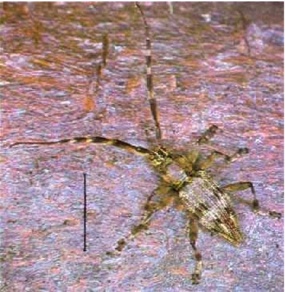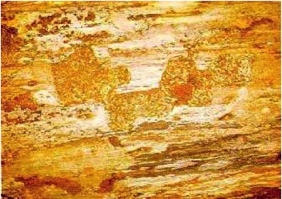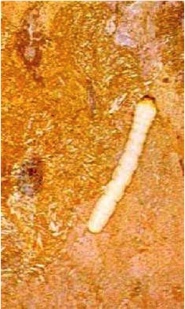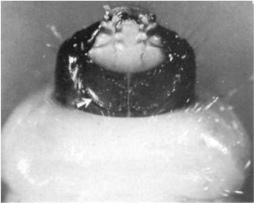PESTS AND DISEASES OF FORESTRY IN NEW ZEALAND
Squeaking longhorn
Scion is the leading provider of forest-related knowledge in New Zealand
Formerly known as the Forest Research Institute, Scion has been a leader in research relating to forest health for over 50 years. The Rotorua-based Crown Research Institute continues to provide science that will protect all forests from damage caused by insect pests, pathogens and weeds. The information presented below arises from these research activities.
Forest and Timber Insects in New Zealand No. 28: Squeaking longhorn.
Revised 2009
Based on G.P. Hosking (1978)
Insect: Hexatricha pulverulenta (Westwood) (Coleoptera: Cerambycidae)

Fig. 1 - Hexatricha pulverulenta adult. The line shows natural length.
Type of injury
The larval tunnels of Hexatricha pulverulenta are oval in cross section and are generally made just under the bark of dead and dying trees. Engraving of the sapwood by the developing larvae is no more than about 2 mm deep. The tunnels become irregular as development proceeds owing to larvae feeding back along their original workings. Tunnels eventually coalesce to form irregular patches of workings packed with a mixture of gritty faecal pellets and wood and bark scrapings (Fig. 2). Hook-shaped pupal tunnels penetrate about 40 mm into the wood. The oval exit-holes made by emerging adults are between 6 and 10 mm in long diameter.

Fig. 2 - Workings under the bark of radiata pine made by larva of H. pulverulenta
Hosts
This insect has been recorded from a wide range of both native and exotic softwoods and hardwoods. It is common in the dead stems and branches of Nothofagus (beech) and Pinus (pine).
Distribution
Hexatricha pulverulenta is a native insect and is found throughout the North and South Islands.
Economic importance
Hexatricha pulverulenta is not of economic importance. It is confined to dead or dying trees and the sapwood damaged is generally removed in the waste slabs cut off during sawing.
Description, life history, and habits
The adult is a longhorn beetle, most distinctive in appearance (Fig. 1). It is dull green with a pair of white stripes on the upper surface of the head. The long feathery antennae bear alternating dark green and white bands. The prothorax is barrel-shaped, wider than the head, and with a central black and orange stripe on its upper surface. The elytra (wing cases) are broader than the prothorax, widest at their mid-point, and strongly tapered to the rear. They are humped in sideview and each bears three longitudinal red-brown ridges. Two transverse black bands are present on the elytra; the one nearer the front is often the more obvious. Behind each band are two patches of white setae (bristle-like hairs). The whole insect bears scattered groups of pale, whitish yellow setae. Body size may range from 10 to 24 mm long and from 3 to 7 mm wide.
The larva of H. pulverulenta is cylindrical, white, slender, tapering to the rear, and up to 35 mm long (Fig. 3). The head is hardened, almost parallel-sided, and generally projects well beyond the prothorax. The under-surface of the head is raised to the rear in a strong semicircular ridge (Fig. 4). The jaws are black and gouge-like at the cutting edge. The prothorax is the widest body segment and the front part of its upper surface is lightly hardened. The abdominal segments each bear a pair of fleshy lobes on their upper and lower surfaces. The lobes are covered with tiny protruberances.

Fig. 3 - Hexatricha pulverulenta larva.

Fig. 4 - The underneath of the head of H. pulverulenta larva.
Arrow indicates the semicircular ridge by which the larva can be identified.
The eggs are usually laid singly between the bark and wood in a small pit 2 to 3 mm deep cut by the female. Natural crevices may be used in thicker bark. The upright main stems of recently-dead trees or upright laterals of felled trees are preferred for egg-laying. The eggs hatch after about 15 days and the larvae mine under the bark, generally engraving the bark more than the sapwood except in thin-barked hosts such as Pseudopanax crassifolius (lancewood).
Pupation usually occurs 20-40 mm into the sapwood in a cell with its open end plugged with coarse shreds of wood. The pupal period lasts about 30 days.
The adults may be found between August and April; they can live up to three months and feed on bark at the margins of damaged areas. When held the beetles stridulate vigorously by moving the prothorax to produce a squeaking sound. The life cycle probably takes from two to three years.
Control
No control measures are necessary against this insect. Parasites known to attack H. pulverulenta larvae are the braconid wasp Doryctes gourlayi Parrott, the ichneumonid wasp Xanthocryptus novozealandicus (Dalla Torre), and a tachinid fly, Calosia sp.
Bibliography
Duffy, E.A.J. 1963: A monograph of the immature stages of Australasian timber beetles (Cerambycidae). British Museum, London. 235 p.
Hosking, G.P. 1978: Hexatricha pulverulenta (Westwood) (Coleoptera: Cerambycidae), squeaking longhorn. New Zealand Forest Service, Forest and Timber Insects in New Zealand No. 28.
Jeffreys, F.J. 1939: Hexatricha pulverulenta Westwood. Transactions and Proceedings of the Royal Society of New Zealand 69: 347-360.
This information is intended for general interest only. It is not intended to be a substitute for specific specialist advice on any matter and should not be relied on for that purpose. Scion will not be liable for any direct, indirect, incidental, special, consequential or exemplary damages, loss of profits, or any other intangible losses that result from using the information provided on this site.
(Scion is the trading name of the New Zealand Forest Research Institute Limited.)

 Farm Forestry New Zealand
Farm Forestry New Zealand

